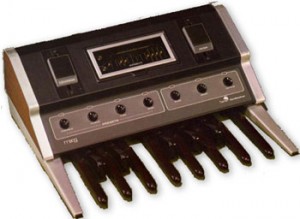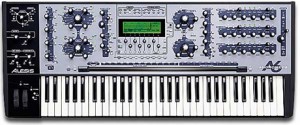Time machine – Exploring the Moog Taurus 1
A voyage into the heart of the Moog Taurus 1 bass pedal from the year 1976.
Exploration by Marko Ettlich (RetroSound)
analog bass pedal
2 VCOs, VCF, VCA
three basic preset sounds: Taurus, Bass, Tuba + Variable Sound
used by Genesis, The Police, Pink Floyd, Marillion, Saga, Jarre, Yes and many more
Inspired by organ pedal boards, Moog released the Taurus Pedal Synthesizer – a monophonic analog bass synthesizer you play with your feet (so you can play other instruments with your hands). Originally, the Taurus was going to be part of a larger ensemble system called the Constellation. It was to include two keyboard synthesizers, the Apollo (polyphonic) and the Lyra (monophonic), and the Taurus foot pedalboard synthesizer. The Constellation project never made it to production, but the Taurus was released on its own, while the Apollo keyboard went on to evolve in to the Polymoog.
The Taurus has three Preset sounds and one User programmable. The three preset sounds are Bass, Tuba and Taurus. Most users prefer the Variable preset which lets them synthesize their own sounds using the simple VCO, VCF and VCA controls. The shaping controls are hidden behind a plastic window to prevent accidental foot tweaking.
The Taurus is monophonic, with sound generation coming from a simple two-oscillator design that can be tuned across a 5-octave range. An Octave button lets you shift the pedal keyboard up or down an octave, the direction must be set using the Octave switch in the Variables section. There’s also a Glide (portamento) effect and a Decay effect. The amount of Glide and Decay are also set in the Variables section. Like any Moog, there is a 24 dB/oct lowpass filter with controls for Emphasis, Contour Amount/Attack/Decay and Cut-Off. Two gigantic foot-sliders flank the sides of the Taurus and they are used to adjust the Filter cut-off and VCA Loudness on the fly using your feet.
MoonSatellite – Emergence Part I
Piece composed by MoonSatellite
Instruments : Alesis Andromeda A6 / Moog Minimoog Voyager / Taurus III / Roland SH 201 / MC 808 / Korg R3 / Akai MPC5000
EHX Flanger Hoax / Polychorus / Deluxe Electric Mistress / Deluxe Memory Boy / Stereo Cathedral Reverb / Stereo Electric Mistress / Memory Man With Azarai
Boss RE-20 Space Echo
Featured hardware:
The Alesis Andromeda A6 is a 16-voice, 16-channel multitimbral analog synthesizer by Alesis which was released in 2000 and discontinued in 2010. The Andromeda A6 is a true analog synthesizer using two analog oscillators per voice, sub-oscillators, hard and soft sync and more! It features 16-voice polyphony. With the Andromeda, you’ll find a huge range of tonal possibilities: searing leads, warm pads, fat bass lines, extreme sound effects and more. And of course there are plenty of knobs (72) and buttons (144), even an assignable ribbon controller for addictive hands-on real-time control! The large high-resolution LCD display is excellent and shows you actual rather than relative values of parameters. Andromeda will integrate seamlessly into any studio with its total MIDI control and sync, individual voice outputs, stereo outputs and several audio inputs.
Andromeda is completely analog – no emulation! It features two analog filters per voice that sound great! They are a multimode 2-pole and a 4-pole lowpass. External audio can be routed through these filters too (three 1/4″ jacks)! As for modulation, Andromeda has three LFOs, each with six waveforms and they can be synced to MIDI clock. And there are three 7-stage envelopes with very creative and flexible functions. Also onboard is an extensive mod matrix for enormous freedom in configuring Andromeda’s sounds!
No analog synth would be complete without a set of classic effects and features. Andromeda also offers Portamento with nine slopes and legato functions. A built-in arpeggiator and analog-style sequencer are available, with MIDI sync! There are also some high quality digital effects such as reverbs, chorus, echo, distortion and more! Andromeda comes with 256 breathtaking preset patches plus 128 user. A PCMCIA-format memory card slot allows for additional programs and mixes.
Taurus 3 :: A Step Outside
You’ve learned all the RUSH cover songs. What else can you do with a Moog Taurus 3?
The Moog Taurus 3 springs from a very iconic lineage. Because of that rich history, it’s easy to type-cast it and not fully explore the full sonic potential it presents. The inclusion of volume, pitch, filter and gate control voltage inputs, coupled with a MIDI-syncable arpeggiator can take it far outside its usual low-end drone duties. This video just scratches the surface of what is possible. Its purpose is to encourage you to “step outside”.
The first example shows the Taurus 3 filter being modulated by a Make Noise René: a very fun analog step sequencer with some interesting Cartesian (X & Y clock) capabilities. The CV inputs on the Taurus 3 make it a great add-on for modular synthesis set-ups and there are an almost unlimited number of interesting things you can connect to them. The René is definitely at the exotic end of the spectrum but it is still extremely useful. It’s great to have that extra level of control available at hand level too.
Due to personal preference, I tend to use things like the René to control filter cutoff instead of pitch. I enjoy the ability to play the notes while synchronized filter events occur. It gives a pleasing (at least to me) mix of tight-sequenced and loose-live feel.
The second example takes things even farther afield. I first discovered the Droid app Nanoloop in a recent CDM article. Its useful features and sleek user interface made it an instant favorite.
Here I used one of my favorite production tricks: processing the Droid audio through a Moog MF-101 (Moogerfooger) low pass filter. In addition to nicely warming up the Droid, it also created a control voltage (CV) proportional to the volume of the input audio. In other words, the CV mirrored the volume envelope of the beat Nanoloop created.
This is an incredibly powerful tool. When that CV controls something interesting… say that filter on a Taurus 3, some very interesting synchronizations occur, all completely in the analog realm. When the Droid outputs a loud kick, the CV output on the Moogerfooger goes high and the Taurus 3 filter opens wide. As soon as the kick sound is over, the CV goes low and the filter shuts. Mid-volume sounds open the filter midway. These are not discrete steps. The CV hugs the volume contour of the input audio and outputs a nicely wiggly, but tightly synchronized analog control signal.
This is conceptually very similar to side-chaining and the great thing about it is that the filter modulations created will follow any changes in the rhythm. Sudden shift in tempo coupled with a time signature change to 11/8… no problem! I haven’t tested it but this should also work with a live drummer. Of course, there is no rule that says you have to connect the CV to a filter input. You could connect it to volume or if you’re feeling really avant-garde, to pitch.
This technique works best with when the beat is not too busy and has some definite dynamic peaks and valleys. A bit of gain adjusting and tweaking of the base filter cutoff frequency on the target synth (the Taurus 3 in this case) are sometimes needed, but the unique results more than make up for this little bit of work. Higher resonance settings on the target synth will make the filter modulations more noticeable. If you have a synth with CV inputs but without MIDI, this is a great way to get it dancing to your beat.
The last example shows a somewhat basic MIDI-synced arpeggiator application. By using your foot to transpose the arpeggiation, you can create quite a sophisticated soundscape while your hands are free for other musical mayhem.
All of these applications are fairly basic. Imagine doing any of them while using the Taurus 3’s USB connectivity to simultaneously control Ableton Live, or while it is part of a monster MIDI stack…




